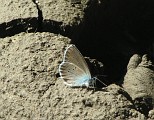Підтримуємо Вільну Україну
 We Support Free Ukraine
We Support Free Ukraine

Biodiversity Map
Taxa

Cyaniris — subordinate taxa:
Taxon count: 1
-
Arthropodaphylum
Click to switch
to select orders
and filters > -
Hexapodasubphylum
Click to switch
to select orders
and filters > -
Insectaclass
Click to switch
to select orders
and filters > -
Lepidopteraorder
Click to set
as the main taxon
and as a base
← of the left panel > -
Papilionoideasuperfamily
Click to set
as the main taxon
and as a base
← of the left panel > -
Lycaenidaefamily
Click to set
as the main taxon
and as a base
← of the left panel > -
Polyommatinaesubfamily
Click to set
as the main taxon
and as a base
← of the left panel > -
Cyanirisgenus
Click to set
as the main taxon
and as a base
← of the left panel >
PL
YES
name status: valid name
BioMap ID: 1203472
taxon code: 2098
taxonomy checked: YES
Data on distribution in Poland

Statistics
- Records: 1675
- Publications: 3
- Collections: 13
- Publication authors: 4
- Illustrations (iconography): lacking
- Photos (specimen/observation): 5
Taxon description
Rozpoznawanie i obserwowanie: Wierzch skrzydeł u samca jest intensywnie niebieski – barwa ta jest nieco ciemniejsza niż u modraszka ikara; u samicy jest jednolicie ciemnobrunatny, bez pomarańczowych kropek. Wzór na spodniej stronie skrzydeł u obu płci jest nie do pomylenia z żadnym innym modraszkiem w naszym regionie, może z wyjątkiem modraszka malczyka. Ale ten ostatni jest dużo mniejszy, a samiec jest brązowy, a nie niebieski.
Rozwój motyla: Samica składa jaja pojedynczo do kwiatostanu, najczęściej jeszcze nie rozwiniętego. Gąsienice żerują o zmierzchu. Młode gąsienice odżywiają się kwiatami, starsze po przezimowaniu młodymi liśćmi koniczyny. Mogą im towarzyszyć mrówki. Przepoczwarczają się na roślinie pokarmowej albo w jej pobliżu.
Okres lotu motyla: Jedno pokolenie w roku: 1/VI –2/VII.
Siedliska: Tereny ruderalne, łąki suche i wilgotne, zarośla, skraje lasów.
Rozwój motyla: Samica składa jaja pojedynczo do kwiatostanu, najczęściej jeszcze nie rozwiniętego. Gąsienice żerują o zmierzchu. Młode gąsienice odżywiają się kwiatami, starsze po przezimowaniu młodymi liśćmi koniczyny. Mogą im towarzyszyć mrówki. Przepoczwarczają się na roślinie pokarmowej albo w jej pobliżu.
Okres lotu motyla: Jedno pokolenie w roku: 1/VI –2/VII.
Siedliska: Tereny ruderalne, łąki suche i wilgotne, zarośla, skraje lasów.
Photos
... browse
 Cyaniris
Cyanirissemiargus
 Cyaniris
Cyanirissemiargus
 Cyaniris
Cyanirissemiargus
 Cyaniris
Cyanirissemiargus
 Cyaniris
Cyanirissemiargus
External data sources
- Ostatnie rekordy
-
1028393
 ×
× Lycaenidae: Cyaniris semiargus (Senn 2015)
Lycaenidae: Cyaniris semiargus (Senn 2015) -
907806
 ×
× Lycaenidae: Cyaniris semiargus, PL (Bąkowski et Mnich 2010)
Lycaenidae: Cyaniris semiargus, PL (Bąkowski et Mnich 2010) -
896348
 ×
× Lycaenidae: Cyaniris semiargus, PL (Blaik 1999)
Lycaenidae: Cyaniris semiargus, PL (Blaik 1999) -
896020
 ×
× Lycaenidae: Cyaniris semiargus, PL (Frąckiel 1999)
Lycaenidae: Cyaniris semiargus, PL (Frąckiel 1999) -
869090
 ⊡
⊡ Lycaenidae: Cyaniris semiargus, PL, Podlasie, podlaskie, Zajęczniki, UTM FD10, 1999, leg. S. Łuczkowski
Lycaenidae: Cyaniris semiargus, PL, Podlasie, podlaskie, Zajęczniki, UTM FD10, 1999, leg. S. Łuczkowski -
869089
 ⊡
⊡ Lycaenidae: Cyaniris semiargus, PL, Pojezierze Pomorskie, pomorskie, Starogard Gdański, UTM CE38, 1998, leg. S. Łuczkowski
Lycaenidae: Cyaniris semiargus, PL, Pojezierze Pomorskie, pomorskie, Starogard Gdański, UTM CE38, 1998, leg. S. Łuczkowski -
869088
 ⊡
⊡ Lycaenidae: Cyaniris semiargus, PL, Pojezierze Pomorskie, pomorskie, Góra, UTM CE28, 1999, leg. S. Łuczkowski
Lycaenidae: Cyaniris semiargus, PL, Pojezierze Pomorskie, pomorskie, Góra, UTM CE28, 1999, leg. S. Łuczkowski -
869087
 ⊡
⊡ Lycaenidae: Cyaniris semiargus, PL, Pojezierze Pomorskie, pomorskie, Orle, UTM CE19, 1999, leg. S. Łuczkowski
Lycaenidae: Cyaniris semiargus, PL, Pojezierze Pomorskie, pomorskie, Orle, UTM CE19, 1999, leg. S. Łuczkowski -
869086
 ⊡
⊡ Lycaenidae: Cyaniris semiargus, PL, Pojezierze Pomorskie, pomorskie, Góra, UTM CE28, 1999, leg. S. Łuczkowski
Lycaenidae: Cyaniris semiargus, PL, Pojezierze Pomorskie, pomorskie, Góra, UTM CE28, 1999, leg. S. Łuczkowski -
865589
 ×
× Lycaenidae: Cyaniris semiargus, PL, Pieniny, Cisowiec, 1959, coll. Muz. Górnośląskie, Bytom: Skalski A.
Lycaenidae: Cyaniris semiargus, PL, Pieniny, Cisowiec, 1959, coll. Muz. Górnośląskie, Bytom: Skalski A. - ... more
- Powiązane publikacje
-
Senn P. 2015. Motyle dzienne Gdyni. Atlas rozmieszczenia. Studio FM, Gdynia. 205 pp.
 Show records
Show records -
Bąkowski M., Mnich A. 2010. Motyle dzienne (Lepidoptera: Papilionoidea, Hesperioidea) Bytowa i okolic. Wiad. Entomol., 29(1):47-55.
 full text
full text Show records
Show records -
Frąckiel K. 1999. Motyle dzienne (Lepidoptera: Papilionoidea, Hesperioidea) Biebrzańskiego Parku Narodowego. Wiad. Entomol., 18(2):85-98.
 full text
full text Show records
Show records -
Blaik T. 1999. Motyle dzienne (Lepidoptera: Papilionoidea, Hesperioidea) wybranych zbiorowisk roślinnych zachodniej części Równiny Opolskiej. Wiad. Entomol., 18(3):153-167.
 full text
full text Show records
Show records
- Powiązane zbiory
-
Muz. Górnośląskie, Bytom
 Show records
Show records -
Muz. Górnośląskie, Bytom: Bielewicz M.
 Show records
Show records -
Muz. Górnośląskie, Bytom: Raebel P.
 Show records
Show records -
Muz. Górnośląskie, Bytom: Rychter W.
 Show records
Show records -
Muz. Górnośląskie, Bytom: Skalski A.
 Show records
Show records - ... more
- Wykaz powiązanych pozycji
-
The Distribution Atlas of Butterflies in Poland
 Show records
Show records





